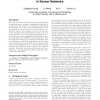1099 search results - page 99 / 220 » On the Complexity of Computing Evolutionary Trees |
BMCBI
2004
14 years 9 months ago
2004
Background: In a previous paper, we introduced MUSCLE, a new program for creating multiple alignments of protein sequences, giving a brief summary of the algorithm and showing MUS...
SIGMOD
2011
ACM
14 years 23 days ago
2011
ACM
We study the problem of computing approximate quantiles in large-scale sensor networks communication-efficiently, a problem previously studied by Greenwald and Khana [12] and Shri...
BMCBI
2008
14 years 10 months ago
2008
Background: There are several situations in population biology research where simulating DNA sequences is useful. Simulation of biological populations under different evolutionary...
ICALP
2009
Springer
15 years 10 months ago
2009
Springer
Abstract. We consider the succinct representation of ordinal and cardinal trees on the RAM with logarithmic word size. Given a tree T, our representations support the following ope...
108
click to vote
AI
2010
Springer
14 years 10 months ago
2010
Springer
Bayesian networks (BNs) are used to represent and ef ciently compute with multi-variate probability distributions in a wide range of disciplines. One of the main approaches to per...



